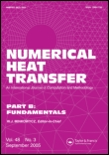
NUMERICAL HEAT TRANSFER PART B-FUNDAMENTALS
Scope & Guideline
Elevating Knowledge in Numerical Heat Transfer.
Introduction
Aims and Scopes
- Numerical Heat Transfer Analysis:
The journal emphasizes the numerical methods used to analyze heat transfer processes, including finite difference, finite element, and lattice Boltzmann methods. - Nanofluids and Hybrid Materials:
A significant focus on the study of nanofluids and hybrid nanofluids, exploring their thermal properties, heat transfer mechanisms, and applications in various engineering fields. - Magnetohydrodynamics (MHD):
Research related to MHD effects on heat transfer in conductive fluids, particularly in the context of nanofluids and complex fluid dynamics. - Bioconvection and Microbial Effects:
Investigating the role of microorganisms in heat transfer processes, particularly in bioconvective flows and their implications for biomedical and environmental applications. - Thermal Optimization and Energy Efficiency:
Studies aimed at optimizing thermal systems, including heat exchangers, thermal management in electronics, and energy storage systems. - Advanced Computational Techniques:
Utilization of artificial intelligence and machine learning techniques for predicting and optimizing heat transfer processes.
Trending and Emerging
- Machine Learning Applications in Heat Transfer:
An increasing number of studies are applying machine learning techniques to optimize and predict heat transfer processes, indicating a growing intersection between data science and thermal engineering. - Hybrid Nanofluids Research:
There is a significant trend towards investigating hybrid nanofluids, exploring their unique thermal properties and potential applications in energy systems and cooling technologies. - MHD Effects in Nanofluids:
Research focusing on the magnetohydrodynamic behavior of nanofluids is gaining prominence, particularly in applications involving energy generation and biomedical devices. - Bioconvection and Microbial Interactions:
The exploration of bioconvective processes and the impact of microorganisms on heat transfer is becoming increasingly relevant, especially in the context of environmental and biomedical applications. - Complex Fluid Dynamics:
There is a growing interest in the dynamics of complex fluids, including non-Newtonian and viscoelastic fluids, particularly in relation to their heat transfer capabilities.
Declining or Waning
- Traditional Heat Transfer Methods:
There is a noticeable reduction in publications focusing solely on classical heat transfer equations without incorporating advanced materials or computational methods. - Non-Newtonian Fluid Dynamics without Nanoparticles:
Research on non-Newtonian fluids that do not involve the study of nanoparticles or hybrid systems has become less prevalent, indicating a shift towards more complex and hybrid models. - Conventional Thermal Conductivity Studies:
Studies focused on traditional thermal conductivity measurements without the integration of advanced computational or experimental techniques have decreased. - Static Heat Transfer Analysis:
Static models that do not account for dynamic conditions or complex interactions (such as MHD effects) are becoming less common in favor of more comprehensive, dynamic modeling approaches. - Single-phase Fluid Dynamics:
Research focusing solely on single-phase fluids is waning, as more studies are integrating multi-phase systems or advanced hybrid fluids.
Similar Journals
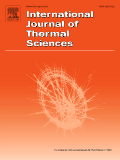
INTERNATIONAL JOURNAL OF THERMAL SCIENCES
Unveiling the science behind heat and matter.The INTERNATIONAL JOURNAL OF THERMAL SCIENCES is a premier academic journal published by ELSEVIER FRANCE-EDITIONS SCIENTIFIQUES MEDICALES ELSEVIER, focusing on cutting-edge research in the field of thermal sciences. With its ISSN 1290-0729 and E-ISSN 1778-4166, this journal has established itself as a crucial resource for scholars and professionals interested in the thermodynamic principles governing engineering and condensed matter physics. The journal is ranked Q1 in both Condensed Matter Physics and Engineering (miscellaneous), highlighting its exceptional quality and influence, as reflected in its impressive Scopus ranks: #32 out of 307 in General Engineering (89th percentile) and #57 out of 434 in Condensed Matter Physics (86th percentile). Researchers and students alike can benefit from the wealth of articles available, with access options designed to foster a wider dissemination of knowledge within the scientific community. Established in 1973 and ongoing through 2025, the journal invites contributions that advance the understanding of thermal phenomena and their applications, solidifying its importance in driving innovation and insight within these dynamic fields.

Propulsion and Power Research
Driving Progress in Fluid Flow and Transfer Processes.Propulsion and Power Research, published by KEAI PUBLISHING LTD, is a leading Open Access journal that has been advancing the field of propulsion and power systems since its inception in 2012. With its commitment to fostering scientific discourse and innovation, the journal has gained a prominent position within academia, achieving a Q1 ranking in multiple categories such as Aerospace Engineering, Automotive Engineering, and Fluid Flow and Transfer Processes as of 2023. With an impressive ranking of #18 out of 153 in Aerospace Engineering and consistent recognition in the Scopus rankings, the journal explores critical advancements and research findings that propel the industry forward. As an Open Access publication, it ensures that groundbreaking research is readily available to a broad audience, enhancing collaboration between researchers, practitioners, and students. The journal's scope encompasses a wide range of topics within propulsion and energy solutions, making it an essential resource for anyone keen on discovering significant developments in this dynamic field.

JOURNAL OF ENHANCED HEAT TRANSFER
Empowering Researchers to Shape the Future of Thermal EfficiencyThe JOURNAL OF ENHANCED HEAT TRANSFER, published by BEGELL HOUSE INC, is a prominent resource for researchers and professionals in the fields of mechanical engineering, fluid flow and transfer processes, and condensed matter physics. With a history spanning from 1993 to 2024, this journal offers a platform for disseminating cutting-edge research and innovations that enhance our understanding of heat transfer phenomena. Although it operates under a traditional subscription model, its impressive standing is underscored by its Scopus rankings—positioned within the 59th percentile for Mechanical Engineering and 58th percentile for Fluid Flow and Transfer Processes. Additionally, it holds Q2 and Q3 categorizations in relevant fields, reflecting its importance in advancing knowledge and applications in heat transfer technology. This journal effectively bridges the gap between theoretical insights and practical solutions, making it an indispensable tool for academics, industrial practitioners, and students eager to explore advancements in thermal management and efficiency.

International Journal of Heat and Technology
Fostering Excellence in Thermal Engineering InsightsThe International Journal of Heat and Technology is a premier academic publication dedicated to the dissemination of innovative research in the fields of thermal engineering, fluid mechanics, and condensed matter physics. Published by the INT INFORMATION & ENGINEERING TECHNOLOGY ASSOCIATION and based in Italy, this journal has been a significant resource for researchers and professionals since its inception in 1983, with a commitment to advancing knowledge until 2024. With an impact factor that reflects its relevance, the journal encompasses diverse topics within its scope, bridging gaps between theoretical research and practical applications. Although currently not open access, the journal provides valuable insights into the nuances of heat transfer, flow dynamics, and material properties, making it a critical reference for academia and industry alike. The journal's Scopus rankings position it within the competitive landscape of chemical and mechanical engineering, highlighting its contribution to advancing these fields. We invite scholars, professionals, and students to engage with the rich content provided within its pages, to foster a deeper understanding of heat and technology in our rapidly evolving world.
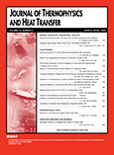
JOURNAL OF THERMOPHYSICS AND HEAT TRANSFER
Empowering Researchers in Thermophysics and BeyondJOURNAL OF THERMOPHYSICS AND HEAT TRANSFER, published by the American Institute of Aeronautics and Astronautics, serves as a vital platform for the dissemination of cutting-edge research in the fields of thermophysics and heat transfer. With an ISSN of 0887-8722 and an E-ISSN of 1533-6808, this journal has been pivotal in enhancing our understanding of heat transfer mechanisms since its inception in 1987, continuing through 2024. It occupies a noteworthy position in various academic categories, boasting Q2 rankings in both Fluid Flow and Transfer Processes and Mechanical Engineering, reflecting its significant contribution to the engineering and physical sciences community. Although it currently does not offer Open Access options, the journal’s repository of rigorous peer-reviewed articles remains accessible to researchers, professionals, and students eager to expand their knowledge and apply innovative findings in aerospace, condensed matter physics, and planetary sciences. Emphasizing both theoretical and experimental approaches, the JOURNAL OF THERMOPHYSICS AND HEAT TRANSFER remains an indispensable resource for advancing the frontiers of engineering and applied sciences.
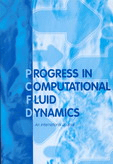
PROGRESS IN COMPUTATIONAL FLUID DYNAMICS
Bridging Theory and Application in Computational Fluid DynamicsPROGRESS IN COMPUTATIONAL FLUID DYNAMICS, published by InderScience Enterprises Ltd, is a vital journal in the realms of Computer Science Applications and Condensed Matter Physics. Established in 2001, this journal serves as a platform for disseminating innovative research findings and technological advancements in computational fluid dynamics, targeting both theoretical and applied aspects. With a current impact factor positioning it in the Q4 quartile for its fields, it captures a wide array of topics including numerical methods, simulation techniques, and real-world fluid dynamics applications, fostering dialogue among researchers, practitioners, and educators alike. Although it does not provide Open Access options, it remains an important resource for those investigating fluid dynamics phenomena. As it continues to evolve through 2024, PROGRESS IN COMPUTATIONAL FLUID DYNAMICS is positioned to contribute significantly to the scientific community, addressing core challenges while promoting collaboration and knowledge exchange.
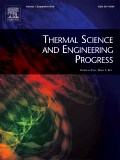
Thermal Science and Engineering Progress
Transforming thermal challenges into engineering progress.Thermal Science and Engineering Progress is a premier peer-reviewed journal published by ELSEVIER, established to bridge the gap between theoretical and practical advancements within the fields of thermal science and engineering. Since its inception in 2017, this esteemed journal has rapidly ascended to a Q1 ranking in the category of Fluid Flow and Transfer Processes, positioning it among the top 17 of 96 journals in this discipline, as reflected by its impressive 82nd percentile ranking in Scopus. With a focus on disseminating high-impact research, Thermal Science and Engineering Progress aims to foster innovation and collaboration by publishing cutting-edge studies that address both contemporary challenges and future directions in thermal management, energy conversion, and heat transfer technologies. Researchers, professionals, and students alike are invited to explore the wealth of knowledge contained within its pages, which are accessible from its headquarters in Amsterdam, Netherlands. This journal plays a critical role in advancing technological progress and fostering a deeper understanding of thermal processes, making it an essential resource for anyone dedicated to these crucial areas of study.

Journal of Engineering Thermophysics
Pioneering research at the intersection of thermophysics and engineering.Journal of Engineering Thermophysics, published by PLEIADES PUBLISHING INC, is a premier academic journal dedicated to advancing the field of thermophysics and its applications across a variety of engineering disciplines. With an ISSN of 1810-2328 and an E-ISSN of 1990-5432, this journal offers an essential platform for researchers and professionals to disseminate cutting-edge findings on the interplay between thermal processes and engineering systems. As of 2023, it is recognized within the Q3 category in key fields such as Condensed Matter Physics, Energy Engineering and Power Technology, Environmental Engineering, and Modeling and Simulation. Moreover, the journal contributes to an important dialogue in the environmental sciences, ranking 111 out of 197 in Environmental Engineering, and positions itself prominently within the academic landscape from its establishment in 2007. Although currently not an open-access journal, it facilitates a selective yet impactful communication of research that drives innovation and knowledge in the thermal sciences. For those engaged in understanding the thermal dynamics essential for sustainable engineering solutions, the Journal of Engineering Thermophysics is the go-to resource for published research, reviews, and advancements in the field.
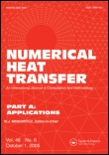
NUMERICAL HEAT TRANSFER PART A-APPLICATIONS
Pioneering research at the intersection of theory and application.NUMERICAL HEAT TRANSFER PART A-APPLICATIONS, published by TAYLOR & FRANCIS INC, serves as a premier outlet for cutting-edge research in the domains of numerical analysis and condensed matter physics. With an ISSN of 1040-7782 and an E-ISSN of 1521-0634, this esteemed journal has steadily maintained its influence in the academic community since its establishment in 1989, continuing its publication into 2024. Currently ranked in the Q2 quartile for both Condensed Matter Physics and Numerical Analysis, it stands as a vital resource for researchers committed to advancing computational methodologies and applications. The journal's Scopus rankings reflect its growing impact, particularly in mathematics, where it is placed in the top 26% of its category. Although not an open-access journal, its comprehensive research articles and detailed applications foster innovation and collaboration, making it essential for professionals and students aiming to deepen their understanding of thermal transfer phenomena through numerical techniques. This journal not only bridges theory and application but also propels forward the field of heat transfer.

INTERNATIONAL JOURNAL OF HEAT AND FLUID FLOW
Connecting Scholars in the Realm of Heat and Fluid FlowFounded in 1979, the INTERNATIONAL JOURNAL OF HEAT AND FLUID FLOW is a premier publication in the fields of mechanical engineering, fluid dynamics, and heat transfer, published by Elsevier Science Inc. With an impressive impact factor and ranking in the Q1 category for Mechanical Engineering and Q2 for Condensed Matter Physics and Fluid Flow and Transfer Processes, this journal is highly regarded for its rigorous peer-reviewed articles that contribute significantly to the advancement of knowledge in these critical areas. Researchers, professionals, and students can access cutting-edge studies that explore the intricacies of thermal and fluid systems, ensuring they stay at the forefront of scientific exploration. The Scopus rankings further affirm its role as a leading source of impactful research, with significant placements in crucial academic categories. Join an active community of scholars committed to innovation and excellence in the exploration of heat and fluid flow phenomena.